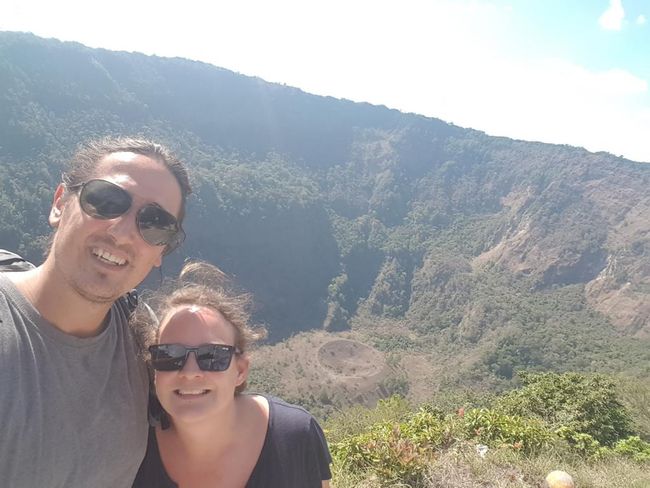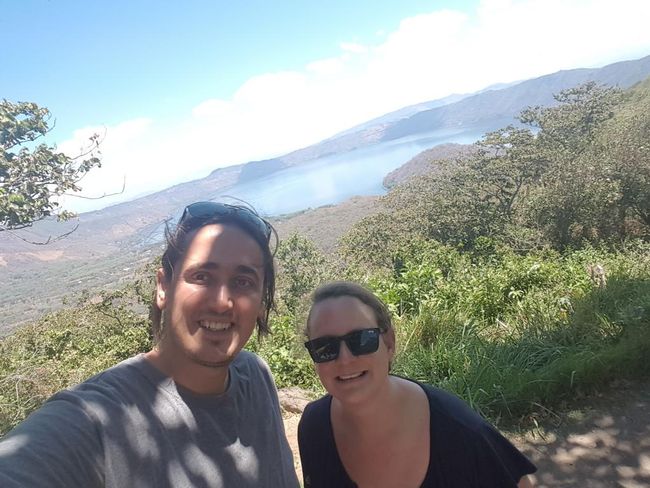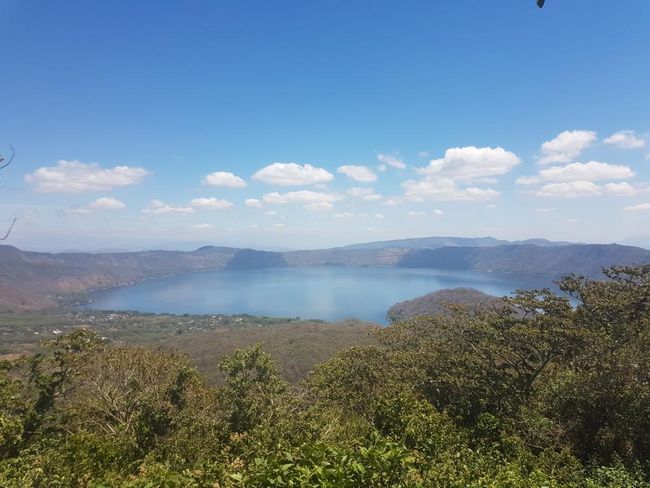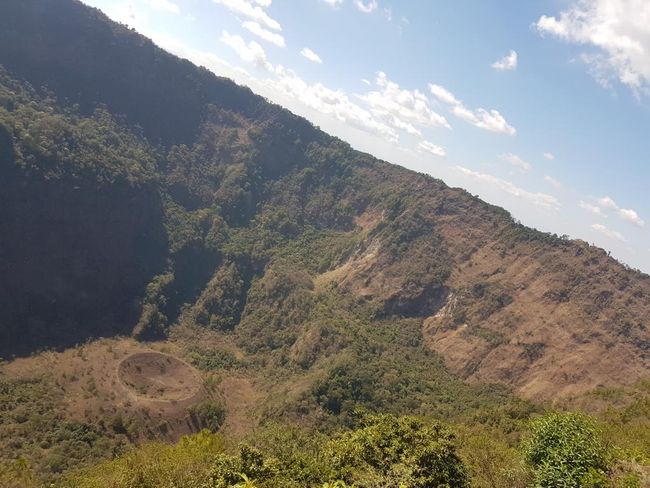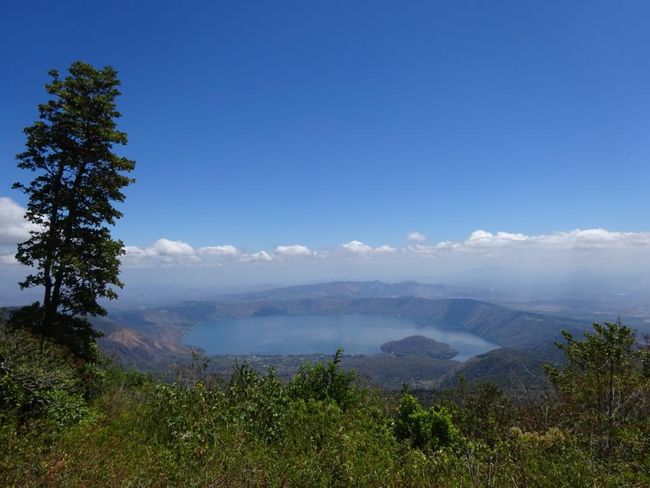El Salvador: San Salvador for the second time
Објављено: 23.03.2018
Пријавите се на билтен
When we returned to San Salvador for the second time, we stayed in an inconspicuous hostel. Luigi, a nice young man, immediately offered us his car and driver to take us anywhere. We gladly accepted and said we would like to go to the volcano.
So the next day at 8:30 am, our driver Luis was ready and we set off. Luis is a very nice and talkative man, and we had an interesting conversation along the way.
We should have noticed it a long time ago. The first time we should have noticed it when Luigi said it would take about 3.5-4 hours to climb the volcano, while we had read that it only takes about 45 minutes. The second time we should have noticed it when Luigi said we would only return at 5:00 p.m. Even though we had already looked at tour providers on the internet who offer the excursion as a half-day tour. The third time we should have realized it was when Luigi told us the price for the trip, which was actually quite expensive considering that the volcano is right next to San Salvador. The fourth time we should have realized it was after sitting in the car for about 2.5 hours. But due to the pleasant conversations with nice people, we didn't realize it until we were almost there: We were at the wrong volcano!
We actually wanted to go to Volcan El Boqueron, which, as mentioned, is right next to San Salvador. The volcano is very special because it has a second small volcanic cone in its huge crater, 45 meters high and perfectly symmetrical, which was formed in 1917 during an eruption.
Instead, Luis took us to Parque Nacional de Volcanos, which is basically halfway across the country. The price was no longer so proud, on the contrary. And so we ended up at Cerro Verde, from where daily hikes start to the neighboring volcanoes Santa Ana and Izalco. But we really didn't feel like hiking for 4 hours in the sweltering heat on this day. So we explained to Luis that it was a misunderstanding. He was very upset and afraid that it was his mistake, that Luigi had actually told him "to Cerro Verde". But we reassured him and explained that it was a misunderstanding between us and Luigi, after all, we had simply said "to the volcano". Who could have known that he would understand the volcano at the other end of El Salvador?
Well... the situation had its advantages. This way, we had the opportunity to see the impressive volcanoes from below, and besides, we had a wonderful view of Lago de Coatepeque, a beautiful blue crater lake with a diameter of 6 km, which was already on our list of "possible flip candidates". So we counted that as "checked off"
Since the day was still young, Luis immediately offered to take us to El Boqueron as well. On the way, we stopped at a Burger King and had lunch together.
After an equally long return journey, we finally reached El Boqueron, where you can drive almost to the edge of the crater. It is a closed park with good infrastructure, where you only have to climb stairs for half an hour to reach the crater rim. There are several viewpoints from where you can look into the crater and at the small volcanic cone inside. Really very cute. There we also met other tourists for the first time in El Salvador, which we could have done without. At the exit of the park, there is a small visitor center where the history of the large and small craters is explained. Well, there is not much to tell, they were just eruptions that formed the craters. That's why the small exhibition was not very exciting.
The travel guide also stated that the view of San Salvador from here is breathtaking. It wasn't. Although there is even an extra observation tower, you couldn't see much of the city because tall trees blocked the view.
We soon made our way back, and after being stuck in traffic for half an eternity on Friday evening, we didn't actually arrive until around 5:00 p.m.
This excursion was truly priceless, but not because of the volcanoes or the lake. It was priceless for us because of Luis, who told us a lot about El Salvador and especially about the problems with the Maras (gangs) here during the drive. We had read a lot about it before, but when you hear the hair-raising stories firsthand, it sends chills down your spine.
In all of Central America, as well as in the United States and parts of South America, there are mainly 2 gangs: Mara Barrio 18 and Mara Salvatrucha (also known as MS-13), which is considered the most aggressive gang of all.
The gangs mainly control the Colonias (residential neighborhoods) outside the big cities, but they terrorize the whole country, or rather, the whole damn continent. The gangs are rivals, and anyone suspected of making common cause with the enemy is cold-bloodedly and ruthlessly killed. Luis tells us that "making common cause" can simply mean driving from one's own neighborhood to a neighboring neighborhood controlled by the enemy Mara. There are people who can no longer visit their families simply because they live in a different part of town. If they did, there was a good chance they would be found dead on the street the next day. Although he still visits his father in San Miguel, which is mainly controlled by MS-13, from time to time, he only stays there briefly. But the people can't just move away either, firstly because they often can't afford it, and secondly because they would also be in danger of setting foot on enemy territory. Once "belonging" to a Mara area, always belonging to that area.
When we passed a large construction site, I asked if the construction company was a government-owned company because I had noticed that the workers on other construction sites were all wearing the same work clothes. He confirmed this and said that it is also very dangerous for the workers. The Maras control the workers in their area, and if they find out that they come from an enemy area, even the construction workers have to fear for their lives just for doing their job.
Bus drivers are also heavily affected, as they have to pay protection money to the Maras. But for that, the bus drivers would drive very recklessly and selfishly, because they knew that nothing would happen to them, after all, they were under the protection of the Maras and paid for it. Not even the police would punish the bus drivers for serious violations because they fear the revenge of the Maras.
In general, neither the military nor the police can do much against the gangs because they fear for their own lives and the lives of their families.
He also told us that it sometimes happens that a wealthy family suddenly finds a cell phone in their mailbox in the morning, or it is brought to them by a stranger. Later, someone calls the cell phone and demands large sums of money in exchange for not killing the family. People are even killed here for just 10 dollars, life doesn't have much value here.
The Maras also have influence on politics. Large security firms or weapons dealers also have no interest in eliminating the gangs, as it would mean a loss of business for them. They would no longer need security personnel, and the Maras are among the biggest buyers of weapons.
Tourists, on the other hand, are hardly victims of murder, he assured us, they are just robbed. We have actually heard this from many people. Maybe it's true, maybe they just say it to reassure tourists and encourage them to travel to the country. Luis even tells us that he knows Salvadorans who have a foreign passport and say that they have much fewer problems with the Maras in their own country and are left alone by them. The gangs only kill their own people, not the foreigners. However, I'm pretty sure that even if a tourist were unfortunately caught in the crossfire, no one would take pity on them.
One sentence that Luis said touched me deeply: Many people would rather wish for the civil war again than the conditions that prevail now. How much suffering is needed for a country to long for a 12-year war with 70,000 deaths?
We ask Luis if there is no way to improve this situation? He says no, it is hopeless. There is no way out. He has resigned himself and accepted the situation. The situation of having to fear for his life if he takes just one wrong step, says something wrong. He has come to terms with it, just like most people here.
The gangs are hierarchically organized, with Clikas forming the lowest level, controlling individual streets or neighborhoods. And even if a high-ranking leader is caught and imprisoned, they will continue to operate from prison through intermediaries. Or there will simply be someone else to take their place.
We argue that education is very important and that more education could perhaps curb the crime. Luis laughs and says that many families no longer send their children to school out of fear that they will fall into the clutches of the Maras there. It's too late. The Maras are already there, in the school.
We had read that even young children in the Colonias are hired by the Maras to carry out tasks for them or stand guard. The children would receive $10 per day for this, earning much more than their parents, who work hard on the coffee plantations every day. We have read that there are children who arbitrarily kill other children as a test of courage. The test of courage that it takes to become a member of the gang, to kill another human being.
Luis tells us something we already knew: The Maras did not exist here before the civil war, and they did not originate here either. They originated in the United States. During the war, many Salvadorans fled to the states in the hope of a better life. In response to the threat of the gangs already existing there, they also joined together and formed their own gangs, such as Mara Salvatrucha, whose founding members were mainly Salvadorans, although you don't have to come from El Salvador to belong to the gang. The name of the gang Barrio 18 comes from 18th Street in Los Angeles.
In the 90s, many illegal Latino immigrants were deported from the United States and had to return to their home countries. They took the gang with them, as well as their brutality and ruthlessness, and from then on terrorized their own compatriots. But the Maras are not only found in El Salvador and the USA, they are also widespread in Honduras, Guatemala, Nicaragua, and parts of South America. We even read on the internet about an attack by MS-13 members on a ticket inspector in Milan. Seriously? Milan? Milan!
At this point, I wonder where the current President of the United States gets the right to call these countries "shitholes". Based on what we have learned in Perquin about the civil war and in San Salvador about gang crime, it seems that the USA is just as responsible for the terrible conditions in these countries.
From time to time, we look at local news on the internet. In the newspaper, there is even a special section called "Violence today". Today there were "only" 10 deaths. The murder rate is estimated to be about 6,500 per year, which would be 18 victims per day. They list their gender, age, whether their identity is known, and where their bodies were found.
What does it take to improve this situation, to save this country and its people? Do all the Maras have to be killed? Another war? A genocide, targeting 60,000-70,000 gang members in El Salvador alone (compared to about 7 million inhabitants)? Is it even permissible to think such things? To say it out loud? To write it down in a blog? I don't know. It all seems so hopeless.
I am thoughtful. Thoughtful and terribly sad. I mourn for this beautiful country and its friendly inhabitants. I mourn for the 10 dead today, for those from yesterday and for those from tomorrow.
Пријавите се на билтен
Одговор
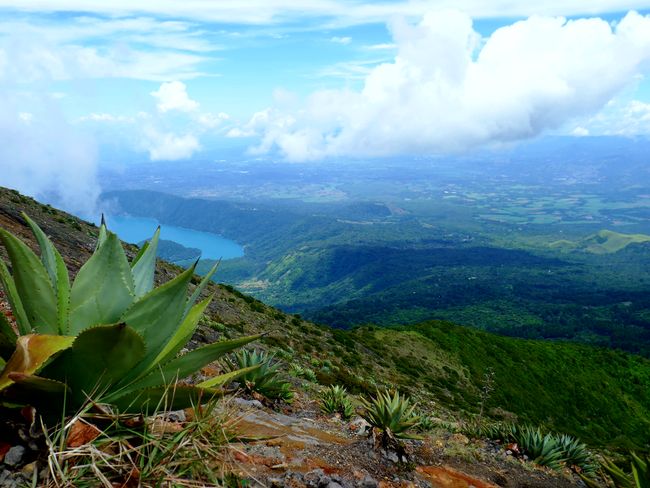
Извештаји о путовањима Ел Салвадор


